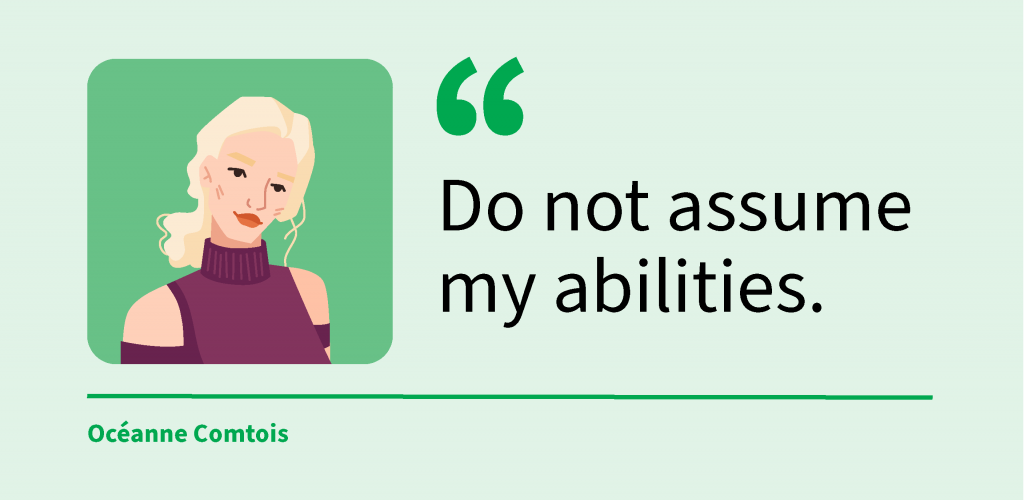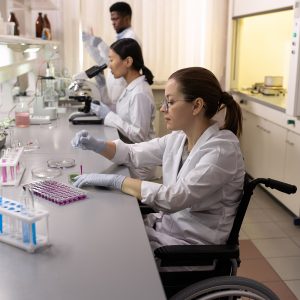2 Disability: Perspective and context matter.
 Océanne Comtois, graduate of Life Sciences program, and legally blind.
Océanne Comtois, graduate of Life Sciences program, and legally blind.
Key Takeaways
- Disabilities fall within a broad spectrum and the learning environment must be taken into consideration when assessing the impact of a disability on student learning.
- Teaching laboratories are a unique learning environment that may present disabled students with unusual challenges.
- When determining how best to support in lab learning, the importance of consulting with a student directly about her/his/their (dis)abilities must be a priority.

A disability is generally defined as any long-term condition of the mind or body that limits a person’s ability to interact with other people and/or the environment. An important nuance to this definition is that each disability falls within a broad spectrum that will include individuals who may not be aware of their impairment (unknown or undiagnosed disabilities) and individuals who have a disability that is not evident to a casual observer (so-called hidden disabilities). Depending upon one’s point of view, disabilities may also be considered to simply represent one end of a spectrum that encompasses the abilities of all individuals. For example, a student with a learning disability may be considered to fall within a continuum of learning abilities inherent within a student population, rather than representing part of a distinct group of individuals that is separate from “normal” learners. An individual’s own perspective is also key to determining whether a person identifies as having a disability or not. Members of the Deaf (uppercase ‘D’) community comprise individuals who are typically born without hearing, are fluent in Sign language as their first language, and have a shared culture; members of this community may hold a viewpoint that their inability to hear is not a disability but rather that they differ in their primary means of communication. Individuals who identify as deaf (lowercase ‘d’) are more likely to have lost their ability to hear after learning language as a young child, and are also more likely to identify their loss as a disability.
Some disabilities will severely limit an individual’s ability to learn and/or interact with(in) all learning environments. In other cases, a given disability may have little to no impact on learning in one instance yet exert a measurable impact on learning in another environment. In other words: context matters and should be considered when assessing how learning may be better supported. This is particularly relevant to ‘in lab’ learning because teaching laboratories are a unique learning environment that may present students with unusual challenges. A student with low vision may excel academically in a classroom environment with the support of assistive technologies, yet it is unlikely that analogous assistive technologies will be available and appropriate to support learning in a teaching laboratory. Conversely, a student with autism spectrum disorder may be at a disadvantage when required to collaborate closely with other students in a group project, but may have no difficulty navigating tasks assigned within a chemistry lab. Thus, a particular student may be considered to have a disability that requires accommodation in one context (for example, in a laboratory setting) and not another (for example, a classroom). This complexity is in fact an asset because it means that learning can often be enhanced by proactively implementing a strategy of diversifying the methods of instruction, task assignment, and assessments of learning (for more details in how this may be accomplished, refer to Resource 4).
When determining how best to support in lab learning, the importance of consulting with a student directly about their (dis)abilities should be a priority. Too often instructors risk the error of assuming limitations based upon their general understanding of the nature of a disability, incorrectly concluding that a disabled student may be unable to complete a course objective that is in fact within their reach. A student who is legally blind, for example, may still be able to discern colours and shapes, and may use these as visual guides to accomplish tasks and participate in lab activities. Conversely, instructors may err in assuming abilities that are beyond the scope of an individual student, unwittingly placing expectations on the learner that are unreasonable or unrealistic for that individual to attain. A student with a disability that manifests in chronic joint pain or joint instability may be perceived to move about ‘normally’ in lab initially but may be unable to stand pain-free without support for the 2-3 hours that typify most lab courses.

